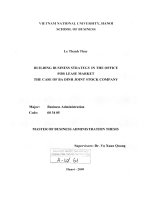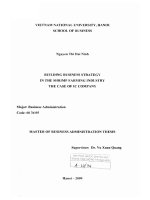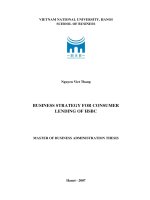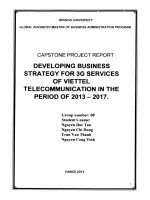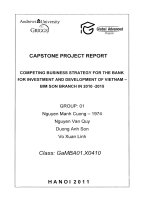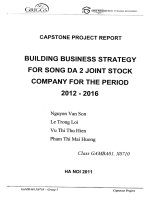BUILDING BUSINESS STRATEGY FOR THE DEVELOPMENT OF THE VIETNAM POSTS AND TELECOMMUNICATIONS GROUP
Bạn đang xem bản rút gọn của tài liệu. Xem và tải ngay bản đầy đủ của tài liệu tại đây (944.96 KB, 124 trang )
THESIS MBA
BUILDING BUSINESS STRATEGY
FOR THE DEVELOPMENT OF THE
VIETNAM POSTS AND
TELECOMMUNICATIONS GROUP
ABBREVIATION
VNPT
The Vietnam Posts and Telecommunications Group
PSTN
Public Service Telephone Network
DSL
Digital Subscriber Line
NGN
Next Generation Network
SWOT
Strength, Weakness, Opportunity, Threat
BCG
Boston Consultant Group
R&D
Research & Development
GPRS
General Packet Radio Service
INDEX
TABLES & FIGURES..................................................................................5
INTRODUCTION.........................................................................................1
I. The necessity of the topic...................................................................................1
II. The purpose of the capstone project report:..................................................2
III.The object and scope of the research:............................................................2
IV.Methodological method:..................................................................................2
V. Contribution of the capstone project report:.................................................2
VI.The layout of the capstone project report:.....................................................2
Chapter I. General Theory of BUSINESS STRATEGIES........................4
I. Concept, characteristics and the role of business strategy in the enterprise:4
II. Strategic management in business..................................................................6
III. Strategic planning:.......................................................................................10
CHAPTER II. Analysis decisive factors of the Vietnam Posts and
Telecommunications GROUP (VNPT).....................................................30
I. Overview of VNPT:.........................................................................................30
II. Organization model:......................................................................................31
III.VNPT’s production and business results in the recent 5 years from 2004 to
2008:..................................................................................................................... 32
IV. Analysis business environment and internal force factors of VNPT.........34
V. Synthesis of internal and external environment analysis............................61
VI. Evaluate the current strategy of VNPT:.....................................................66
CHAPTER III. PROPOSE BUSINESS STRATEGIES FOR VNPT’S
DEVELOPMENT IN THE PERIOD 2011 -2015 AND
IMPLEMENTATION SOLUTIONS........................................................76
I. Foundation to build strategy...........................................................................76
II. Propose business strategy for VNPT’s development in the period of 2011 –
2015 and implementation solutions....................................................................79
PETITION.................................................................................................102
CONCLUSION..........................................................................................104
LIST OF REFERENCE...........................................................................106
APPENDIX................................................................................................108
TABLES & FIGURES
Diagram 1.1. Process of strategic management..........................................8
Diagram 1.2: Process of strategic planning..............................................11
Diagram 1.3. Simulation of the business environment in the enterprise
.......................................................................................................................13
Diagram 1.4: M.PORTER’s model of 5 forces.........................................15
Table 1.5: List general analysis and forecasting inside and outside
business environment:................................................................................20
Table 1.6: External factors evaluation matrix (EFE)..............................22
Table 1.7 SWOT matrix.............................................................................26
Table 1.8: QSPM Matrix............................................................................28
Diagram 2.1: Organization model of Vietnam Posts and
Telecommunication Group.........................................................................32
Table 2.2. General analysis of macro-environment.................................39
Table 2.3: Market share of telecommunications in 2008.........................43
Table 2.4: Image matrix of competition....................................................46
Table 2.5. Overall of micro environment..................................................52
Table 2.6. Synthesis of VNPT’s internal forces........................................58
Table 2.7. External factor evaluation (EFE).............................................61
Table 2.8. Internal factor evaluation (IFE)...............................................64
Table 2.9 VNPT's revenue from 1999 to 2008..........................................67
Diagram 2.10 VNPT's revenue from 1999 to 2008...................................68
Table 2.11: Market share of telecommunications enterprises in 2008...69
Diagram 2.12: Market share of telecommunications enterprises in 2008
.......................................................................................................................70
Diagram 2.13: Market share of fixed telephone.......................................70
Diagram 2. 14: Market share of mobile....................................................71
Diagram 2. 15: Market Share of the Internet...........................................71
Table 3.1 Brief SWOT matrix for VNPT.................................................79
Diagram 3.2: Organization model proposed for VNPT..........................88
Table 3.3: Human resources structure......................................................93
Diagram 3.4.Human resources structure..................................................93
INTRODUCTION
I. The necessity of the topic
We has just gone through 20 years of the country reformation, changing from
the centrally planned bureaucratic subsidy to the market mechanism under the
Government’s control, according to the socialist oriented direction. Besides the
gigantic achievements in political, economic, cultural, social field in comparison
with the period before renewal, we must acknowledge that Vietnam still held quite
a far distant compared with other countries, that we are still poor, has low growth
and are slowly integrating into the international environment.
In this term, our soceity in general and our enterprise in particular is facing
with both opportunities and challenges when domestic and international
environment is changing all the time. Technical and scientific factors which are
the decisive factors for the economic growth, is rapidly renewed. Consumption
soceity is growing out of the framework of a country, reaching to the global needs
and demand. The process of international environment intergration (participation
and commitment to implementing AFTA, APEC, WTO, especially Vietnam-US
trade agreement) complies with the common rule, common value and ensuring the
fair security.
In such circumstances, to survive and to thrive, the Vietnam Post and
Telecommunications enterprises must adapt to new requirements: changing
business environment from monopoly to competition, with the expansion of
unlimited participation of the international factors. Competition ability is the
decisive factor, determining the survival of each enterprise. The post and
telecommunication enterprises, especially the system of state-owned enterprises
must construct the strategic business planning and point out appropriate methods
of plan implementation as a weapon to compete in the market or to measure the
level of their development. In the Vietnam Post and Telecommunications Group
currently does exist a dependent accounting block of large scale which maintain
way to build business strategies according to the central mechanism, and hasn’t
effectively made use of its existing advantageous resources.
Page 1
From that way of thinking, our Group 5 has determined to choose the topic of
“Building business strategy for the development of the Vietnam Posts and
Telecommunications Group in the period of 2011-2015”
II. The purpose of the capstone project report:
Do research; build business strategy for the development of Posts and
Telecommunications Group of Vietnam.
III.The object and scope of the research:
-
Object: The Vietnam Posts and Telecommunications Group
-
Scope: Using basic reasoning method and strategy building methodology,
strategy management based on the practices and trends of competition in the
postal and telecommunications service, from which contribute its part to
complete the formulation of business strategy for the VN Posts and
telecommunications development until 2011 and sin the orientation of 2015,
strive to make VNPT become one of the best enterprises in providing postal
and telecommunications service.
IV.Methodological method:
Our capstone project report uses the method of dialectical materialism in
combination with logical and historic method, using method of analysis and
synthesis, statistical methods, survey methods, comparison and forecast.
V. Contribution of the capstone project report:
Our capstone project report provides scientific methodologies and assesses of
the situation and proposes some content in order to improve the formulation of
business strategies to ensure the development objectives of the Group until 2011
and in the orientation to 2015.
VI.The layout of the capstone project report:
Besides the contents, list of abbreviations, list of tables, drawings, introduction,
conclusion, reference list, appendix, the content of the essay is divided into three
major chapters:
+ Chapter I. General theory of business strategy of the enterprise
Page 2
+ Chapter II. Analysis decisive factors of the Vietnam Post and
Telecommunications Group
+ Chapter III: Propose business strategies for VNPT’s development in the
period of 2011-2015 and implementation solutions
Page 3
CHAPTER I. GENERAL THEORY OF BUSINESS
STRATEGIES
I. Concept, characteristics and the role of business strategy in the
enterprise:
I.1 The concept of business strategy:
Economists and researchers are more and more interested in business
strategy and have come up with many definitions of the term "business strategy".
Each definition has its own characteristics depending on the perspective of each
author.
Author Glueci supposed that "Strategy is a plan of uniformity,
comprehensiveness, and synthesis, designed to ensure that the objectives of the
business will be done."
According to General Arlleret: "Strategy is the goal determination and
measures taken to reach the goals through the policies”.
Other authors such as M. Porter and Alain Threlart consider business
strategy as the art of competition on the market and achieving business
development.
With Chandler, "Strategy is to identify the goals and objectives of the longterm business and to apply a series of actions as well as the allocation of resources
needed to achieve these objectives".
However, to sum up, strategy is a system of long-term goals, policies and
measures on the organization, business, finance, human resources in order to reach
the business goals pointed out.
From these different ideas above, the concept of business strategy which is
supported by many authors are:
"Strategy is a series of actions to mobilize resources to achieve a certain
purpose".
Page 4
I.2. Characteristics of business strategy:
Although there are many concepts and approaches of different categories of
strategies, basic features of business strategy is rather united. The basic
characteristics are:
- Business strategy has its orientation in a long time. It points out the target, the
business direction for each specific product. It clearly defines the basic tasks,
solutions to step by step achieve their objectives. Business strategy is flexible,
being built for a long time of 5 years or 10 years, and it consists of a continuous
process from the stage of construction to the implementation, inspection and
supervision.
- All important strategic decisions in the process of building and organizing the
implementation, evaluation and strategy management are focused on senior
management team to ensure the standards of long-term decisions and the
confidential information in competition.
Thus, from the concept and these characteristics above, we can simply
understand that: "Business strategy is a process of identifying the overall goal to
develop business and use all of techniques element, economic organizations and
business to win in the competition and to achieve its objectives”
The market economy is always changing, to survive and to develop, it requires
the adaptability to such fluctuations. Modern business management supposes that
the enterprises cannot survive in this market change without a suitable business
strategy. Only on that basis, does the enterprise recognize the need to take
advantage of opportunities or threats occurring to timely find a best solution. Lack
of a proper business strategy demonstrating the initiative and attack, lack in
building and developing business strategy, the enterprise can not run its business
efficiently and in many case it even leads to the bankruptcy.
Business strategies help the enterprise to orient its direction to reach its goal by
its own efforts; helping the enterprise determines their fundamental goals which
should be achieved in each period. These goals should be fully consistent at all
levels, all fields in business activities or organs, in order to exploit and optimize
make use of the resources, to promote the advantages and to snatch up
opportunities to gain advantage in competition.
Page 5
II. Strategic management in business
II.1. Concept of strategic management
Theory of "Strategic management" was after the birth of "strategic" theory.
And there are many different ideas on strategic management. But, we can simply
understand that:
"Strategic management is a set of management decisions and actions
determined for the long-term performance of the company”.
Strategic management includes: Environment analysis (both internal and
external environment), strategy building, plan implementation, and strategy
evaluation process. Strategic management should focus on the environment
analysis, the external opportunities and threatens in the condition of internal
strength and weakness. Strategic management is to analyze the main determining
factors and the capability inside the company.
From which we can understand the strengths and weaknesses of the company
to take the external opportunities and minimize the risks due to internal problems
caused.
II.2. The necessity of strategic management in the enterprise:
Many researches by T.J. Andersen have shown that organizations applying
strategic management will achieve better performance compared to other
organizations without using this method. The match between the organizational
environmental, structure and processes will create positive effects for the
organization performance.
Strategic management helps companies well-organize their goals and measures
that should be taken to achieve their goals. It shows where the enterprises are and
what they should do in the future to achieve their goals.
Business environment is constantly changing, and is becoming increasingly
fierce, which requires companies to have flexible reactions to survive and to grow.
Strategic management requires the ability of analysis and forecast such changes in
the business environment. By analyzing and forecasting, can the board of manager
make a wise decision to take advantage of opportunities; minimizing the impact of
the risk, winning an active position under these changes of the environment. In
Page 6
contrast, businesses which do not apply strategic management often react
passively and come up with many disadvantages in business.
- Strategic management helps businesses implement their strategies in
compliance with other departments to optimize use of their resources to achieve
the objectives set out. Strategic management will eliminate the overlapping among
departments, reasonably reallocate their resources and facilitate the inspection of
the strategy implementation in the business.
- In short, strategic management today has really become an important part in
each enterprise. Without a suitable strategy and without a good strategic
management, businesses will be difficult to survive.
II. 3. Process of business strategic management:
In the process of strategic management, the manager should make a series of
activities as follows:
Page 7
Input
Internal
Environment
Strategic goals
External
Environment
Stragic
reactions
Strategy building
Company
strategy
Active
Competition
Strategy
implementation
Corporation
strategy
International
strategy
Cooperation
strategy
Company
management
Structure
and
control
Management
strategy
Starting
a
business and
innovation
Strategy
achievements
Acquisition,
restructure
Process
of strategic
management
Feedback
Competition
strategy and average
profit
Source: Strategic management lecture slide-Griggs
Diagram 1.1. Process of strategic management
II.3.1.Internal and external environment analysis:
Before deciding the direction or making an appropriate response, it is
necessary that each enterprise analyze the current situation. To analyze the current
Page 8
situation, it requires the consideration of organizational context, the environmental
perspective outside and inside the organization:
- The internal factors of the enterprise: strong or weak.
- The environmental factors outside the business: opportunity or risk.
- The willingness of the leadership: corporation value, reputation and
competitive advantage.
II.3.2. Strategies building:
Building strategies is included in the designation and the selection of
appropriate strategy for the organization. To accomplish this, it should be
considered from many organization levels, to set out different types of strategies:
- Company strategy: Take the interest in the large and long-term problems such
as how to run business, what business field to participate in, and what to do in that
business type. Any changes in the structure of the business organization can lead
to change in the company strategy.
- Function strategy: They are the decisions and actions toward the short-term
target to construct different function parts in each organization such as production
part (manufacturing), marketing, research and development, human resources,
financial accounting, information technology.
- Competition strategy: The competition strategy researches the competitive
advantage that organizations want to achieve and considering how to compete in
each specific business field.
II.3.3 Strategy implementation:
The strategy formation or construction is not enough, it is necessary that the
strategy should be well-implemented. Strategy implementation is the process to
put the different strategies of the organization into practice. Measures of strategy
implementation are attached with strategies construction.
II.3.4 Strategy evaluation:
The final phase of strategic management is the strategy evaluation. All
strategies are subject to future change because inside and outside factors are
changing regularly. Three major activities of this phase are: (1) review the basic
Page 9
factors of current strategies, (2) measuring the achievements and (3) naking
adjustment in the operations. Stage of strategy assessment is needed because the
current success does not guarantee future success. Success always creates new
problems. Organizations which have thought of full satisfaction would pay an
expensive price for the decline.
III. Strategic planning:
III.1. Concept of strategic planning:
Strategic planning is the process of using suitable methods, tools and
techniques to determine the appropriate business strategies for the enterprises as
well as to identify function strategies for each business part in a specific period.
III.2. Process of strategic planning:
This process can be generalized according to the Table below:
Page 10
Vision, mission and strategic goals of the business (1)
Analysis of
enterprises (S, W)
(3)
Analysis business
environment (O, T)
(2)
Strategy selection (4)
Company strategy (5)
Business strategy
Function strategy
Strategy implementation (6)
Examine & evaluate implementation
results (7)
Feedback
Source: Lecture slide of strategic management – Griggs University
Diagram 1.2: Process of strategic planning
III.2.1. Vision, mission and strategic goals of the enterprise:
III.2.1.1. Vision:
Vision shows the highest and the most common goal of the organization. It
describes the desire to achieve. It is extremely important because it defines
Page 11
directions, indicating the priority, being the basis for the planning and encouraging
all efforts to achieve organizational goals and ideals.
III.2.1.2. Mission:
Any business has its own mission. Mission is a key, the concentration to
release the potentiality of the organization.
Mission statement describes its organization, its customers, and its
development required to meet its vision. Mission is a statement, which creates the
foundation for the strategic planning. It is the reference point for the assessing the
strategic goals.
III.2.1.3. Determining strategic objectives of the enterprise:
Goal is the future status which the company aims at. Setting targets is a very
important step in the process of building strategies. As the determination of proper
goals is a basis for action-oriented strategies. It determines the next step of the
construction phase as well as strategies implementation. Target is a base to
evaluate and to adjust strategies. It must have four following characteristics:
- First, the goal must be accurate and measurable.
- Secondary, it should aim at the important mission of the organization.
- Third, objectives must be challenging but can be performed.
- Fourth, objectives must be determined in a specific period
There are short-term and long term goals.
- Long-term goal: the overall desire that the business wants to achieve in a
longer period longer than one year, with specific content: the profit, productivity,
competitive position, job creation, community relations, technology location, and
social responsibility.
- Short-term goal: the last desired results that companies expect to achieve in
each business cycle.
III.2.2. Analysis business environment of enterprises:
The purpose of environment analysis is to identify the opportunities and risks
for the enterprises, including analysis the macro environment and micro one. It is
Page 12
the process of considering various environmental factors and determining the
influence of chance or risk on the enterprise. Judge the environment (diagnostic)
basing on the analysis and review of environment from which to take the initiative
to face with the risks affecting the business. The environment analysis includes:
analysis of the macro environment and micro-environment analysis (also known as
environmental sector).
Macro environment:
Economic factors
Legal and political elements.
Social elements
Macro environment consists of the
external factors that affect
business.
- Working environment includes
external industrial elements,
orient competition in that
economic sector.
- Internal environment consists
of resources inside the enterprise
Nature element
Economic
sector environment:
Technical
elements
Competitors
Customers
Suppliers
Potential competitors
Substitute
products
Internal
enterprise environment
Human resources
R&D
Manufacturing
Account and finance
Marketing
Organization cultures
Source: Business strategy – by Nguyen Van Nghien - P.33
Diagram 1.3. Simulation of the business environment in the enterprise
III.2.2.1. Analysis of macro environment:
III.2.2.1.1 Economic environment:
The economy situation and its trends affect the strategy success of the
enterprise, the main factors are the economic growth, interest rates, inflation,
unemployment, exchange rates. Variation of these factors will affect business.
III.2.2.1.2 Technical environment:
Technological factors influence on the business strategy of enterprises and
even on the whole industries. Therefore, it is very important to judge the trends of
Page 13
industry development. Changes in technology affect the life cycle of products and
services.
The dimension/events in the technology may be opportunities for those
companies which are able to mobilize investment capital, but it would be a threat
to the companies with old technology.
III.2.2.1.3 Socio-cultural environment:
For strategic management, cultural and social factors are sensitive and
changeable ones. Lifestyle of the inhabitants themselves is rapidly changing
toward importing new lifestyle, which leads to change in consumer attitudes.
Higher level of education helps to increase the consumer’s demand for higher
quality, a wide range of products categories. This is a big challenge for
manufacturers.
Each business enterprise is running its business in a different socio-cultural
environment. Business and socio-cultural environment have a close relationships
and impact on each other. Society provides resources for the businesses; consume
its products and services. Socio-cultural environment can affect strategic decisions
such as selecting areas and items, selecting the brand, color, style, or changing the
channels.
III.2.2.1.4 Nature environment:
Environment factors include geography, climate, and ecological environment.
Threats from climate change have a big impact on business. Therefore anticipation
the factors of climate and weather change makes the business more active in
making decisions about their products.
III.2.2.1.5 Environment, government, law, politics:
Legal and political factors influence the development strategies of enterprises
in different directions. They can be opportunities for this business but the risk for
the other enterprises. Open policies encourages more open economic sectors to be
involved in producing, but a risk for the state-owned enterprises, an opportunity
for private manufacturers business participating into the market.
III.2.2.2 Analysis of environmental sectors (work environment):
Page 14
Working environment includes all factors that directly influence the decisions
of the enterprise in a sector. Any industry consists of many businesses providing
similar products and services or substitutes; the problem is to analyze, to judge the
competitiveness of environment to determine the opportunities and threats to each
business. Hereby is a very popular model of Michael Porter with five competitive
forces:
New
competitors
Suppliers
potential
Competitors
Customers
Substitute products and
services
Source: Lecture of Strategic Management – by Le Van Tam- P.45
Diagram 1.4: M.PORTER’s model of 5 forces
III.2.2.2.1 Analysis of existing competitors:
The first element in the model of M. Porter is a competition scale affecting the
opportunity to increase price and to earn more profit. Competition between
enterprises in the industry often focuses on the following main contents:
- Nature of competition: competition among the substitutes-competition of
priorities when purchasing the product of different value, placing in the
relationships of revenue; competition in the same category of products;
competition between brands.
- Competition pressure in economic sector: competition structure is the
competition in the company population and scale competing in the same business.
If the business is small, no business dominates the others; the structure of
competition will be distributed. If market demand is huge, competition pressure
Page 15
will decrease, in contrast, if market demand is small, the competition will become
fierce.
- Barriers to exit from the industry: When business conditions deteriorate,
facing with difficulties in the business, forcing the businesses to consider
withdrawing from industry sector; costs when withdrawing from the business
sector is making losses and even bankruptcy, including:
+ Cost of investment: factories, equipment, technology.
+ Direct costs of investment preparation, and administrative procedures.
+ Social costs: training workers, firing workers.
III.2.2.2.2 Analysis of potential competitors:
The potential competitors are likely to enter the enterprise sector in the future,
threatening to the current businesses. Current businesses often try to prevent the
potential competitors participating into its industry because it will make the
competition increasingly fierce and the profits will be shared, and even the
location of the business can be changed. Level of profit of potential rivals depends
mainly on the participation cost whether it is high or low (barrier industries),
including:
- The higher initial capital investment is, the less ability to join the industry.
When you start taking a business, you must put a certain amount for procurement
of inputs such as machinery, raw materials, to create outputs. Thus, the more the
original investment is, the greater the risk it may encounter, traders want to enter
the industry must take consideration when making the investment decision.
- Price advantage: When companies hold high technology, they are able to
create the products with low cost, and thus, create competition advantage. To keep
this advantage, businesses must always be the leader in technology; focusing on
business management to reduce costs, and to improve production efficiency in
business.
- The advantage of products labels, goods and services: The customer is
familiar with the brand name which is often used. The cost of building brand new
goods usually takes more time and creates big costs.
Page 16
- The advantage of production scale: The large production scale help to reducs
the fixed costs per unit produced; large-scale enterprises will have a competitive
advantage over new competitors as much.
- Legal barriers: are the provisions of the Government on the conditions to
participate into the market such as the condition of chartered capital, the
equipment, the level of the workforce ... this strict regulation will interfere in the
business sector.
III.2.2.2.3 Pressure from suppliers:
Suppliers are likely to be a threat when they raise prices, limit their quantity, or
stop to provide quality products. Enterprises should pay attention to the negative
impacts from the suppliers. However, providers can only be pressure for
businesses in the following cases:
- There are few suppliers.
- There are few substitute products and services.
- Have the special advantage of specialized products and services.
- Its ability to vertically integrate to own one part or overall production
capacity.
III.2.2.2.4 Customers pressure:
Customers are common nouns to refer to people or organizations using the
product or service business. Customers can be divided into five following subjects:
the final consumer; distributor’s intermediaries: agents and wholesalers; the
industry buyers.
Customers are the main target to be involved in the consuming products;
identifying customers and the impact on customers is to determine the basis of
products market, services and investment structure needed. Customer’s demand is
one key factor in the production and business interests to decide whether it should
or should not be maintained long-term competitive advantage for one product. The
higher pressure from customers is, the higher risk of disadvantage in businesses it
may create.
Customers often make pressure for businesses in the following cases:
Page 17
- They are large customers buying in large scale.
- There are many suppliers with similar product of many options.
- Ability to backward integrate to own all or part of the production.
When customers have the advantage over the seller, it is indispensable to
reduce the price and increase product quality, service, which means that profits
will decrease.
III.2.2.2.5. The substitute products:
Substitute products does not have seriously competitition but it can affect on
the making profit ability of the market, which is a threat to business. It is
necessary to pay special attention to the substitute product, which are likely to
improve and to change due to advances in technology. Most new replacement
product is the result of the explosion of technology. To achieve success in
business, enterprises need to spend the necessary resources to develop new
technologies in development strategies.
III.2.2.3 Analysis of internal business environment:
Internal business environment is all elements that belongs to the enterprise
itself, which is directly involved in production and operations to identify strengths
and weaknesses; providing the basis for strategic planning and business strategy
implementation. Object to be considered are the main factors occur inside the
enterprise, under the control of the business. The main factors are: human
resources, finance, accounting, marketing, information systems, and organizational
system.
III.2.2.3.1 Factors of human resources and organization:
Human resources play a very important role in the success of the enterprise.
People provide input material to plan the objectives, making the environmental
analysis, selecting and testing strategies of enterprises. Only people who work
efficiently, create effectiveness for the enterprise, elements of human resources
including:
- The leadership, professional qualifications and experience of the leadership.
- Organization and suitable management.
Page 18
- The skill, the morality of the staff employees, the flexible and efficient
policy.
III.2.2.3.2 Factors of research and development (R & D):
Research and development in the business can help companies maintain it solid
leadership position in the industry. Factors of production research and
development, including: experience, competence, application of scientific and
technical achievements in production to meet increasing demand in the market.
III.2.2.3.3 Factors of financial accounting:
Functions of financial accounting department includes analysis, planning
implementation and inspection, helping to set up the financial statements, timely
reflecting the financial situation of the company. Financial accounting department
impacts directly to all areas of activities, with main responsibilities related to
financial resources, and are able to mobilize short-term and long-term capital for
investment and development programs of the company, controlling the financial
expenditure regime, the cost of capital, the price, plan cost, financial costs and
profit.
III.2.2.3.4 Factors of production, technology:
Production activities are associated with the creation of products, affecting the
success of the business. They include all factors related to technical production,
production technology, productivity, ability to control production costs, inventory,
and raw materials supplement. Factors of production, technical capabilities show
the enterprise’s ability to meet quality and quantity required by the market
demand. Controlling the production costs are important, which relates to pricing
policy of goods products.
III.2.2.3.5 Factors of marketing, products consumption:
Marketing department of the business is very important in the consumption its
goods, which does the market research to set out policies on product, price,
distribution channels, to improve the production of new products, to supply goods
of a large scale, to collect market information to identify appropriate policies for
enterprises.
Page 19


